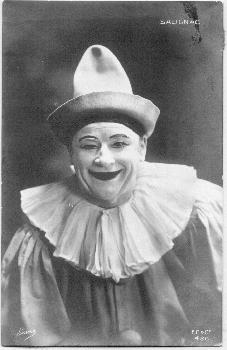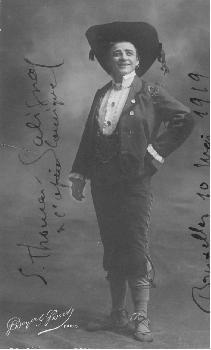Eustase Thomas-Salignac
19 March 1867 Générac – 16 November 1943 Paris
| Eustase Thomas-Salignac sings | La fille du régiment: A cet aveu, with Marcella Sembrich
|
Up to this day, Thomas-Salignac's name creates considerable confusion: Thomas seems to be the first name, Salignac the
surname. Not so; he was born Eustase Thomas, and Salignac was his wife's maiden name, which he adopted because it's far
less frequent than Thomas. His stage name, thus, was Thomas-Salignac, always used (as it was customary in France) without
any first name.
The son of a café owner, he grew up in Marseille, where he also began studying violin and voice (as a baritone); he
completed his studies (now as a tenor) at the Conservatoire National in Paris. After making his debut in Richard
Coeur-de-Lion at the Opéra-Comique in 1893, he sang a few small parts there. Via Aix-les-Bains, Trouville and
Reims, he came to the New York Met in 1896. He stayed for one season, and then continuously from 1898 to 1903, singing a
total of 252 performances: as Don José, Roméo, Alfredo, Gounod's Faust, Philémon (Philémon
et Baucis), Almaviva, Lyonel, Don Ottavio, Fernand, Duca, Wilhelm Meister, Ernesto, Edgardo, Turiddu, in Verdi's
Requiem, as Canio, Shahabarim (Salammbô), Massenet's des Grieux, Tonio (La fille du régiment),
in Rossini's Stabat mater, and as Tamino. From 1897 to 1899 and from 1901 to 1904, he was also regularly at Covent
Garden in London.
Then he returned to France, to Nice and Monte Carlo first, and in autumn 1905, he rejoined the Opéra-Comique, where
he appeared into the 1920s, not least in several world premieres (the only work that is not totally forgotten is Xavier
Leroux's Le chemineau, premiered on 6 November 1907). He added Julien, Marouf, Werther or Cavaradossi to his
repertory. Guest appearances at various Paris theaters (Opéra included), in Zürich, Brussels or (as late as
1926) Amsterdam.
Before World War I, he was director of the Nice opera theater; during the war, he served in the Red Cross. From 1923, he
taught at the Fontainebleau conservatory (where Charles Kullman was
his student), and from 1924 he was, for many years, a professor at the Conservatoire National. In 1926, he toured
the US and Canada with his own troupe.
In 1922, he founded the important French music periodical "Lyrica", whose editor he was until 1939.
Under the Nazi occupation of northern France, he was one of the most prominent collaborationists, actively contributing to
the music section of the "Groupe Collaboration", an association of intellectuals advocating friendship with the Nazis.
Thomas-Salignac was one of the foremost French tenors of his generation; unfortunately, he is almost unrecorded. In fact,
his voice is only (barely) known from a handful of technically less than satisfactory Mapleson cylinders; he made also
four Bettini cylinders in 1899, but they're probably lost.
Reference 1: Metropolitan Opera archives; reference 2: Kutsch & Riemens; reference 3: Oscar Thompson, The
international cyclopedia of music and musicians, London 1975; reference 4: Art Lyrique Français, reference 5
I want to thank Georges Cardol for the picture (top).
I wish to thank Eduardo Gabarra for having provided a clean up version of the IRCC recording of the Mapleson cylinder.
|

